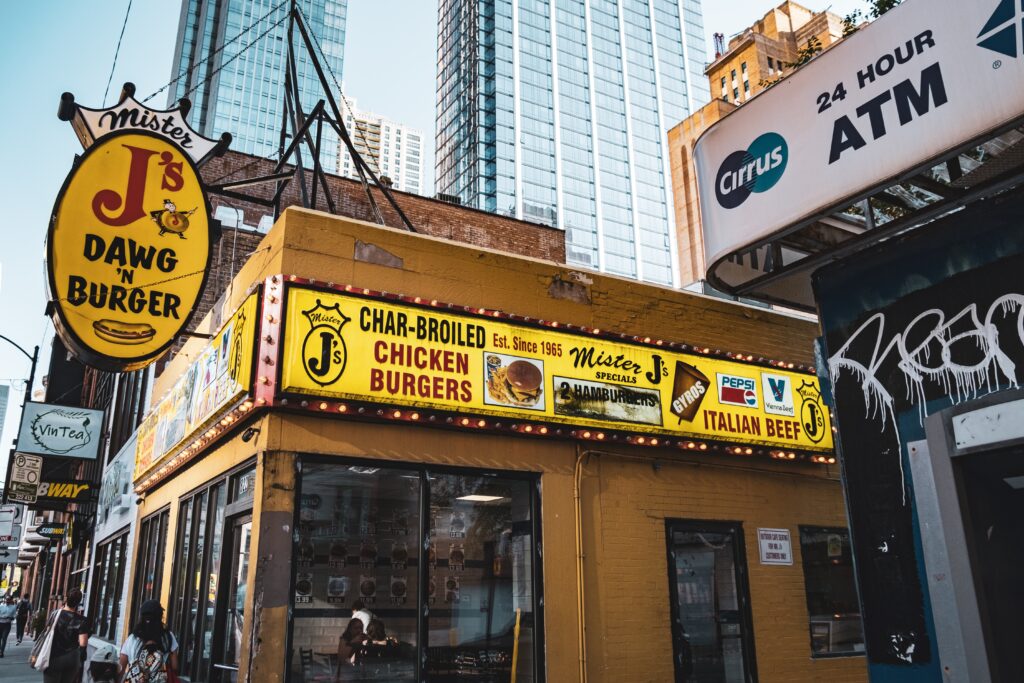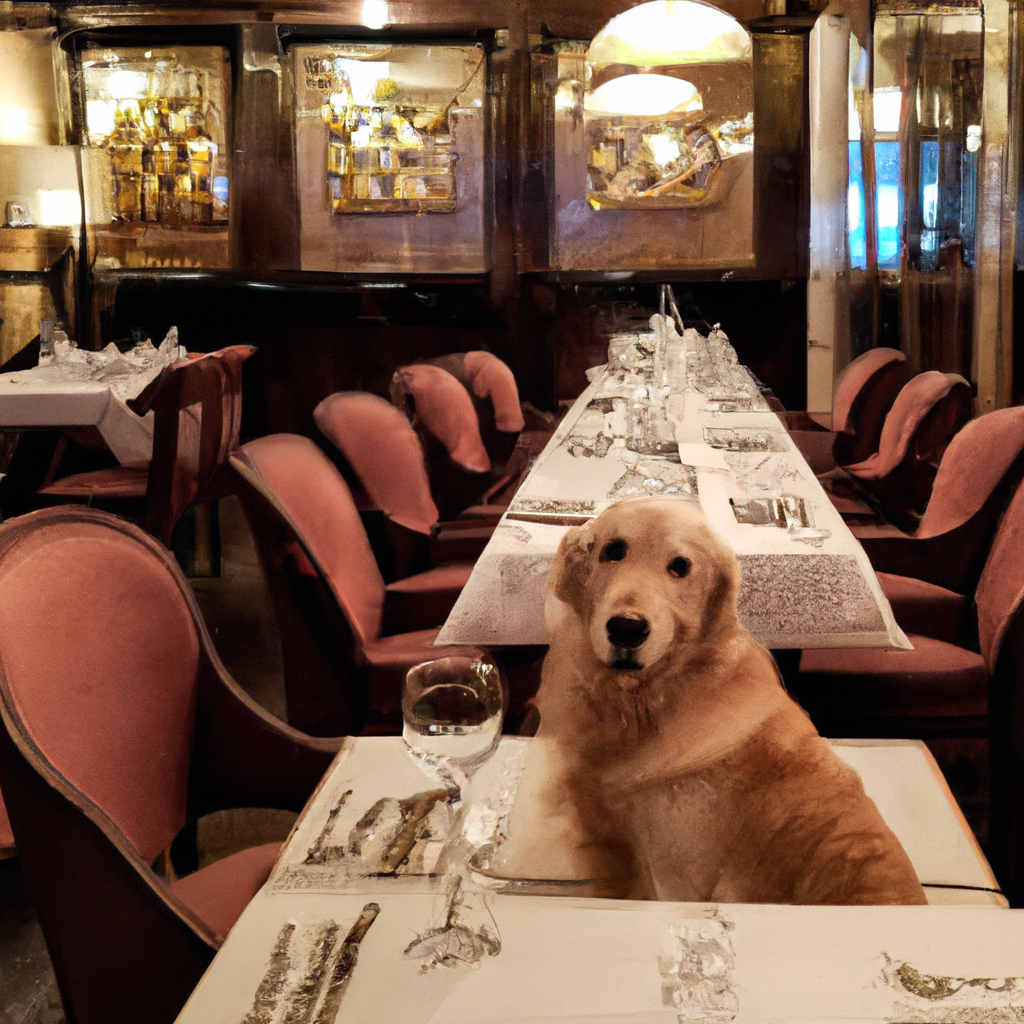Have you ever wondered whether you can take your beloved furry friend with you when you go out to eat? Well, the answer may surprise you. In the United States, the rules and regulations regarding dogs in restaurants vary widely from state to state. While some states have strict guidelines that prohibit dogs altogether, others are more lenient and allow them in certain outdoor dining areas. So, if you’re eager to enjoy a meal with your canine companion by your side, it’s essential to know the specific regulations of the state you’re in. Let’s explore the fascinating world of dogs in restaurants in the USA and discover where your furry friend is welcome.

This image is property of images.unsplash.com.
Laws and Regulations
Federal Laws
When it comes to the regulations surrounding dogs in restaurants, it is important to consider both federal and state laws. At the federal level, the Americans with Disabilities Act (ADA) protects the rights of individuals with disabilities who use service animals. According to the ADA, service animals are defined as dogs that are specifically trained to perform tasks for individuals with disabilities. These tasks may include guiding individuals who are visually impaired, alerting individuals who are hearing impaired to sounds, or providing assistance with physical tasks.
State Laws
In addition to federal laws, each state may have its own laws and regulations regarding dogs in restaurants. While some states may follow the ADA guidelines, others may have stricter regulations in place or leave the decision up to individual establishments. It is important to research the specific laws in your state to ensure compliance.
Local Laws
In addition to federal and state laws, local jurisdictions may also have their own regulations regarding dogs in restaurants. These regulations may vary from town to town or even within different neighborhoods of the same city. It is important to be aware of any local ordinances that may apply and to adhere to them accordingly.
Service Animals vs. Pets
Definition of Service Animals
Service animals, as defined by the ADA, are specifically trained to perform tasks for individuals with disabilities. These animals are working animals, not pets. They are trained to assist individuals with various disabilities and are granted legal access to public places, including restaurants. It is important to note that service animals are not limited to dogs, as miniature horses can also be trained as service animals in certain circumstances.
Rights of Service Animals
Service animals have specific rights under the ADA. They are allowed access to all areas of a restaurant where the general public is allowed, including dining areas. It is important for both business owners and patrons to understand that service animals are not pets and are legally protected under federal law. Individuals with disabilities who rely on service animals should not be denied entry or service based on their service animal.
Requirement of Documentation
While the ADA does not require service animals to be registered or have specific identification, business owners may ask two questions to determine if an animal is a service animal: (1) Is the dog a service animal required because of a disability? and (2) What work or task has the dog been trained to perform? However, it is important to note that business owners are generally not allowed to ask for documentation or proof of the animal’s training.
Pets in Restaurants
Unlike service animals, pets are not granted the same legal access to public places, including restaurants. In most cases, pets are not allowed in areas where food is prepared or served due to health and safety concerns, such as potential contamination risks.
General Guidelines for Pets
While pets may not be allowed inside restaurants, many establishments offer pet-friendly outdoor seating options. These areas provide a suitable environment for individuals to dine with their pets while following health and safety regulations. It is important to respect the rules and guidelines set by each individual establishment to ensure a positive experience for all customers.
Food Safety Concerns
Health Code Regulations
Health code regulations play a crucial role in determining whether dogs are allowed in certain areas of a restaurant. These regulations are in place to protect public health and maintain a clean and safe environment for both customers and employees. Most health codes prohibit animals from entering food preparation areas or areas where food is served to prevent potential contamination and the spread of diseases.
Potential Contamination Risks
Allowing animals in areas where food is prepared or served can pose serious contamination risks. Pets may shed hair, dander, or allergens, which can potentially be ingested by customers. In addition, animals can carry bacteria or parasites that can be transmitted to humans through contact with food or surfaces. These risks can be especially concerning for individuals with allergies or compromised immune systems.
Sanitation Requirements
To maintain a safe and clean environment, restaurants are required to follow strict sanitation requirements. This includes regular cleaning and sanitizing of surfaces, utensils, and equipment. Allowing animals in prohibited areas can compromise these efforts and increase the risk of cross-contamination. By adhering to health code regulations, restaurant owners can ensure the safety of their customers and prevent potential health issues.
Restaurant Policies
Variation in Policies
Due to the varying laws and regulations surrounding dogs in restaurants, each establishment has the discretion to establish its own policies. Some restaurants may strictly adhere to health code regulations and not allow dogs on their premises, while others may offer specific areas for pets and their owners. It is important for restaurant owners to review applicable laws and regulations and establish clear policies to ensure consistency and compliance.
Outdoor Seating Options
Many restaurants and cafes offer outdoor seating options, which can be a suitable alternative for individuals who wish to dine with their dogs. Outdoor seating areas allow pets and their owners to enjoy a meal together while maintaining compliance with health and safety regulations. This can be a win-win situation for both restaurant owners and customers, as it provides a solution that accommodates the needs of pet owners while still prioritizing the well-being of all patrons.
Leash and Restraint Rules
To ensure the safety and comfort of all customers, it is important for pet owners to adhere to leash and restraint rules. This includes keeping dogs on a leash and under control at all times. By following these rules, pet owners can prevent potential incidents and disturbances, allowing everyone to have an enjoyable dining experience.
Dog-Friendly Menus
Some dog-friendly restaurants go above and beyond by offering specially curated menus for dogs. These menus may feature a variety of canine-friendly options, including fresh water, treats, and even specially prepared meals. This not only enhances the overall dining experience for pet owners but also promotes a pet-friendly culture and encourages individuals to bring their dogs along when dining out.
Updates during COVID-19
The COVID-19 pandemic has posed numerous challenges for the restaurant industry, including policies related to dogs in restaurants. Many establishments have had to reassess their policies and make adjustments to ensure the safety and well-being of their customers and staff. While outdoor seating options have become more popular during this time, it is essential for restaurants to stay informed about local guidelines and regulations to determine the best course of action.

This image is property of images.unsplash.com.
Customer and Public Opinions
Support for Dogs in Restaurants
The topic of dogs in restaurants evokes a wide range of opinions. Many individuals, particularly pet owners, support the idea of allowing dogs in certain areas of restaurants. They argue that dogs are important members of their families and allowing them to accompany their owners enhances the overall dining experience. Furthermore, they believe that dog-friendly policies promote inclusion and create a welcoming atmosphere for all customers.
Health and Allergy Concerns
On the other hand, there are valid health and allergy concerns associated with allowing dogs in restaurants. Some individuals may have allergies or sensitivities to animals, which can be triggered by exposure to pet hair, dander, or saliva. For these individuals, dining in an environment where dogs are present can be uncomfortable or even pose serious health risks. It is important for restaurant owners to consider these concerns and strike a balance between accommodating pet owners and ensuring the comfort of all customers.
Liability and Disturbance Issues
Restaurant owners also need to consider the potential liability and disturbance issues associated with allowing dogs on their premises. Dogs, especially those that are not properly trained or socialized, may exhibit behaviors that can disrupt other patrons or pose a risk to their safety. It is crucial for owners to establish clear rules and guidelines to prevent any potential incidents and protect the well-being of all individuals present.
Alternatives and Solutions
Dog-Friendly Establishments
For those who wish to dine with their dogs, there are establishments that cater specifically to this demographic. These dog-friendly establishments create an environment that welcomes both humans and their furry companions. These establishments often have specific areas designated for pets and their owners, allowing them to dine together in a safe and comfortable environment.
Pet-Friendly Outdoor Dining Areas
As mentioned earlier, many restaurants and cafes offer pet-friendly outdoor seating areas. These spaces allow individuals to enjoy a meal with their dogs while adhering to health and safety regulations. By providing these outdoor options, restaurants can accommodate the needs of pet owners without compromising the dining experience for other customers.
Pet-Friendly Cafes and Bars
In addition to restaurants, there are also pet-friendly cafes and bars that cater specifically to individuals who wish to spend quality time with their dogs. These establishments often feature designated indoor and outdoor areas where dogs are welcome. Whether it’s enjoying a cup of coffee or sipping on a refreshing beverage, pet owners can find solace in these pet-friendly venues.

This image is property of images.unsplash.com.
Benefits of Allowing Dogs
Increased Revenue
One of the primary benefits of allowing dogs in restaurants is the potential for increased revenue. By welcoming dogs, establishments can attract a larger customer base and tap into a market that consists of pet owners who actively seek out pet-friendly environments. This can result in higher occupancy rates and increased sales, ultimately benefiting the bottom line of the business.
Enhanced Customer Experience
Allowing dogs in restaurants can greatly enhance the overall customer experience. For many pet owners, their dogs are an integral part of their daily lives and being able to bring them along enhances their dining experience. By providing a pet-friendly atmosphere, restaurants can create a unique and welcoming environment that fosters a sense of belonging and encourages repeat business.
Promotion of Pet-Friendly Culture
By embracing dogs in restaurants, establishments can actively promote a pet-friendly culture within their communities. This can have a positive effect on society as a whole by encouraging responsible pet ownership and fostering an inclusive environment for all individuals. By publicly supporting dogs in restaurants, establishments can contribute to the overall well-being and happiness of their customers.
Case Studies
Successful Dog-Friendly Restaurants
There are numerous successful dog-friendly restaurants across the United States that have found the right balance between welcoming dogs and ensuring a positive dining experience for all patrons. These establishments have implemented clear policies and guidelines to maintain cleanliness, prevent disturbances, and protect the safety and well-being of both customers and dogs. By studying these success stories, restaurant owners can gather valuable insights and explore best practices to implement in their own establishments.
Examples of Strict Policies
On the other hand, there are establishments that have chosen to adopt strict policies against allowing dogs. These businesses prioritize health and safety concerns and may not have the infrastructure or resources to accommodate pets on their premises. By examining these examples, restaurant owners can gain a better understanding of the challenges and considerations associated with dogs in restaurants and make informed decisions about their own policies.

Conclusion
The topic of dogs in restaurants is a complex one that involves navigating federal, state, and local laws, as well as health and safety considerations. While service animals are legally protected under the Americans with Disabilities Act and granted access to all areas of a restaurant, pets are generally not allowed in areas where food is prepared or served. However, many establishments offer outdoor seating options or have specific areas for pet owners to enjoy a meal with their dogs. By adhering to regulations, implementing clear policies, and considering the needs and concerns of all customers, restaurant owners can create a welcoming and inclusive environment that accommodates both humans and their furry companions.


